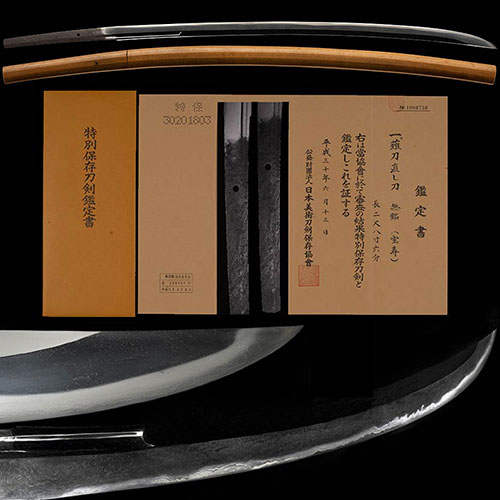
宝寿 長巻直し刀Houju Nagamakinaoshi Katana
No.153926産茎長巻直し刀 宝寿 平安末期 900年前 舞草鍛冶 身幅3.4cm重量1.15kgの豪壮傑作刀 二尺八寸六分Ubu-Nakago Nagamaki-Naoshi-Katana Houju Late Heian 900 years ago Mogusa Blacksmith A magnificent sword with a wide Mihaba and a weight of 1.15kg 86.7cm
ご成約Sold
- 極めKiwame
- 宝寿Houju
- 登録証Registration
- 東京都 Tokyo 平成15年4月8日 4/8/15(Heisei)
- 時代Period
- 平安末期 Late Heian
- 法量Size
-
刃長 86.7cm (二尺八寸六分) 反り 2.2cm
元幅 2.2cm 元重 0.74cm 鎬厚 0.78cm 茎長 25.7cm 重量 1,150gHachou 86.7cm (二尺八寸六分) Sori 2.2cm
Moto-Haba 2.2cm Moto-Kasane 0.74cm Shinogi-Thikess 0.78cm Nakago-Chou 25.7cm Weight 1,150g - 国Country
- 奥州Osyu
- 姿Shape
- 長巻直し造、庵棟、身幅広く、反り深く、先反りつく。Nagamaki-Naoshi-tsukuri, Iorimune, Wide Mihaba, Deep Sori, Saki-soritsuku
- 鍛Kitae
- 板目肌に、杢目交じり、地沸微塵につき、大肌交え、肌立つ。Itamehada, Mixed Mokume, Jinie entered finely,Mixed Oh-hada, Hadatatsu.
- 刃文Hamon
- 焼き落としがあり、直刃調に、浅くのたれて、互の目・小互の目交じり、湯走り・二十刃頻りにかかり、足入り、小沸よくつき、金筋長く頻りに掛り、匂口潤みごころに明るく冴える。Yakiotoshi, Suguha-style, Shallow-Notare, Gunome, Mixed small-gunome, Yubashiri, Nijuba-shikirinikakari, Ashi entered, Smalll-Nie entered well, Kinsuji-shikriini-kakari, Nioikuchi-Urumigokoro is bright and clear.
- 帽子Boushi
- 直ぐに焼き詰めごころ。Suguni-yakitsumegokoro
- 茎Nakago
- 産ぶ、先切、鑢目勝手下り、目釘孔一。Ubu, Sakikiri, Yasurime-kattesagari, Mekugiana is one(1)
- ハバキHabaki
- 白鞘一体。Integrated with Shirasaya
- 説明Drscription
- 舞草(もぐさ)鍛冶は、平安中期に陸奥で起こった反乱討伐の前九年の役、五三年の役の後より、寛治元年(1087年)頃から奥州藤原氏の繁栄の元で、平泉で名工を輩出しており、古備前正恒の父も舞草鍛冶であったとという。舞草鍛冶には、在銘作が非常に少なく、在銘作が現存しているのは宝寿のみとなる。宝寿は、舞草鍛冶の代表工で、平安末期に源義経を育てた藤原秀衡のころ平泉で活躍した。この刀は、長巻直しで、鍛は、板目肌に、杢目交じり、地沸微塵につき、地景が入り、肌目に粕立つところがあるなど、宝珠ならではの地肌の見どころが伺える。刃文は、7cm程大きく焼き落とし、直刃調に、小互の目交じり、湯走り・二十刃かかり、足入り、小沸よくつき、金筋長く頻りにかかり、刃中良く働き、匂口潤みごころに明るく冴える。古研ぎとなり、長い時を経て肌立った所はあるが、二尺八寸六分の生ぶの侭の作刀時の姿を留める希少なもので、出来が良く、身幅3.4cm、重量も1,150gもある豪壮な迫力溢れる傑作刀である。Mogusa smithing began in the middle of the Heian period, after the 9-year war and the 53-year war to suppress the rebellion that occurred in Mutsu, and from around 1087 under the prosperity of the Oshu Fujiwara clan. , Hiraizumi produced master craftsmen, and it is said that the father of Ko-Bizen Masatsune was also Mogusa smith. There are very few works with signatures in Mogusa blacksmiths, and Hoju is the only one with signatures. Hoju was a representative blacksmith of
Mogusa, and was active in Hiraizumi during the late Heian period when Fujiwara no Hidehira raised Minamoto no Yoshitsune.
This sword is Nagamakinaoshi, Kitae has Itamehada, Mixed Mokume. Jinie entered finely, Chikei entered, There is a Hadame-Kasutatsu place, and you can see the highlights of the background unique to Houju. Hamon is about 7cm Large Yakiotoshi, Suguha-style, Mixed Small-Gunome, Yubashiri, Nijuba-kakari, Ashi entered ,Small-Nie entered well, Kinsuji hangs over and over long, It works well in sword Nioiguchi-Urumigokoro is bright and clear. It is Furu-togi Although there is a Hadatatsu place after a long time, it is a rare item that retains the appearance of Ubu sword when it was made. It works well, 3.4cm Mihaba, Weight 1.150g It is a masterpiece It is a magnificent sword.


